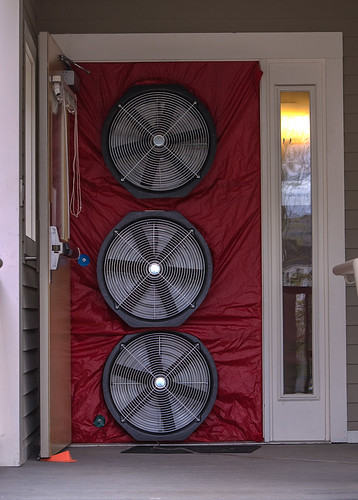Is there an area in your house that always feels extra drafty? Can you never seem to get a particular room at a comfortable temperature? Chances are you have some air leakage in your home. While some are leaks are inevitable, an overly leaky home can significantly increase energy costs and make your home less comfortable. If you suspect you have a substantial amount of leakage in your home, you may want to consider having a blower door test done.

A blower door test is a way to determine how airtight a home is and how much ventilation you will need to provide an acceptable indoor air quality. If a home is leaking air, those leaks can increase energy costs and create moisture condensation problems. Air leaks can also create uncomfortable drafts during the winter months. A blower door test allows a homeowner to identify where those leaks are so that they can seal them and reduce energy costs for a home.
How Does a Blower Door Test Work?
The basic principle of a blower door test is simple. A calibrated fan is mounted to the frame of an exterior door that pulls air from the house, creating a pressure difference between the interior of the home and the outdoors. The fan blows air out of the house, and the higher outside air pressure pushes air in through unsealed cracks and openings. The auditors may use a smoke pencil to find the leaks inside the home. In addition to finding leaks, the test also determines the rate at which air is coming into the home.
Blower Door Test Equipment
There are three pieces of equipment that you need to conduct a basic blower door test: a digital air pressure gauge or manometer, door panel system, and a fan. The variable-speed fan pulls air from the home to depressurize it. The air pressure gauge measures the difference between the air pressure inside and outside the home.
There are two types of door pressure systems that can be used for the test: calibrated or uncalibrated. Uncalibrated blower doors can locate leaks in homes. While this is beneficial, it doesn’t provide any way to determine the overall tightness of the home. A calibrated door, on the other hand, has gauges that measure the amount of air that the fan is pulling out of the house. This allows the auditor to determine the amount of air leakage that the homeowner is experiencing as well as determine the effectiveness of an air-sealing job.
What Is a Good Blower Door Test Result?
You’ll receive a report at the end of the test that will let you see how airtight your home is. In the report, you’ll see a reading for the ACH, an acronym that stands for Air Changes per Hour. This tells you how often the air in your house would be entirely replaced if the fan ran nonstop. An ACH of five is a good result for older homes and indicates a home that is semi-airtight. For a new home, you should have an ACH of at least four. An ACH between six and nine indicates a house that is moderately leaky, and a reading over nine indicates a very leaky home.
Another test result you’ll see on the report is the CFM, which stands for cubic feet per minute. This reading indicates the amount of air that’s moved through the fan during the test. While this number is less important than the ACH, it does tell you if more air is being drawn into the house because it has a large amount of leakage. For example, a CFM below 1250 tells you that your home is reasonably airtight. If the CFM is between 1300 and 3000, it is moderately leaky. If the CFM is over 3000, you should definitely seal the leaks because the reading indicates an extremely leaky home.
Should You Get a Blower Door Test?
If you are considering the test as a way to reduce your energy costs, deciding whether you need a blower door test performed is a personal decision. If you have a newly constructed home, many state building codes are starting to require blower door and duct testing from certified third parties on new construction homes. If you are thinking about buying a house or building one, then it’s a good idea to have a blower test performed, even if it isn’t required, as it can impact future energy bills.
If you are experiencing high energy bills or there are areas of your home where you experience drafts or have trouble cooling your home, we recommend an air leakage test. Leakage around doors, windows, foundation seals, old caulking, ductwork, and pipe and wire feed throughways are often the cause of problems. An auditor can locate the source of your problem and recommend steps you should take to resolve it and reduce energy costs.
How to Prepare for a Blower Door Test
While the auditor will be responsible for conducting the test, it’s also helpful for the homeowner to take steps to prepare the home for the blower door test and also to provide the auditor with insight about potential air leaks. Some steps you can take to prepare for a test are to:
- Point out for the auditor areas of the home that are often drafty or rooms where it’s difficult to achieve a comfortable temperature
- Expect the auditor to need to access all areas of your home, including attics, crawl spaces, built-in cabinets, and closets
- Close all exterior doors and windows and open all interior doors
- Close any fireplace dampers or woodstove air inlets
You should expect the test to take approximately an hour, depending on the size and complexity of your home.
How Much Does a Blower Door Test Cost?
The cost of a door blower test depends on the square footage of your home. However, if you’re in the Valparaiso, Ind. area, you can contact us for a quote.
At Energy Diagnostics, we work with our clients to ensure they are getting a service they’re happy with. If you need assistance with your home’s energy performance or with new construction code compliance, we are here to help. Contact us today.
Image via Flickr by BillSmith_03303
